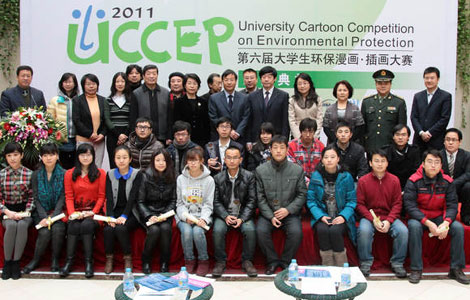China's marine industry upgrades
Updated: 2012-01-09 13:49
(Xinhua)
|
|||||||||
JINAN - The coastal city of Rongcheng in East China's Shandong province is known as China's "land of kelp" -- producing nearly half of the country's sea tangle. The plant was mainly used for extracting cheap industrial iodine only a few years ago, when a local company saw new possibilities in the seaweed.
In 2008, Shandong Haizhibao Ocean Science & Technology Co Ltd introduced seeds from Japan and cultivated a new type of kelp that is thinner, shorter and more appetizing, using it to produce organic "green food" such as noodles and beverages.
The company's sales revenues have since increased tenfold, with products being exported to overseas markets such as Japan, the Republic of Korea and the United States.
The development of Rongcheng's kelp industry is a prime example of how Shandong's "blue economy" development strategy has allowed the province to take advantage of its numerous marine resources to build up its economy.
In April 2010, the State Council, or China's cabinet, approved the establishment of the Shandong Peninsula Blue Economic Zone as one of three pilot zones for the development of China's marine economy.
The economic zone covers 159,500 square km of offshore waters and 64,000 square km of land in six cities and two coastal counties. A development plan for the economic zone was approved by the State Council in early 2011 as part of China's national development strategy. According to the plan, the Shandong provincial government will coordinate the development of its land and marine economies and strengthen exploration, especially in emerging marine industries.
One year after the plan was approved, Shandong has made significant achievements and become a national leader in exploring seaside economics.
According to Zhang Chaochao, director of the Shandong Provincial Development and Reform Commission, the economic zone has earmarked 14 sectors for improved development, including fishing, marine equipment manufacturing and marine eco-protection.
In the meantime, Shandong will push for the development of emerging marine industries in the fields of biology, new energy and new materials, Zhang said.
Marine-related companies in coastal cities like Qingdao, Yantai and Weihai are taking advantage of the plan to expand their business or upgrade their services.
The Qingdao-based Bright Moon Seaweed Group has gone from being an iodine producer and seaweed processing plant to a modern company with a variety of products such as food additives, cosmetics, non-woven fabrics and medical supplies.
"Our products have been continuously upgraded. There is a bright future for the utilization of seaweed," said Li Kechang, technical director of the company.
Behind Shandong's marine industry are technical support and innovation, both of which have allowed the industry to transform and upgrade itself through the years.
Founded in 1993, the Yantai-based Huadong Soft-Tech Co is now a leading IT solutions provider in the port and shipping industries. Its software products have snatched about 60 percent of the domestic market and have been utilized at nearly all of the country's harbors.
"Technical innovation is the essential driving force for the development of the Shandong Peninsula Blue Economic Zone," said Jiang Yikang, secretary of the Shandong Provincial Committee of the Communist Party of China (CPC).
China has abundant marine resources, with 3 million square km of offshore waters and 32,000 km of coastline.
However, the marine economy accounts for no more than 10 percent of the country's gross domestic product (GDP), and mainly focuses on traditional industries such as fishing, transport and tourism, which together account for two-thirds of the country's total marine output.
Emerging industries, including marine-related biomedicine, power, chemicals and seawater utilization, only account for 5 percent of marine output.
However, with its ambitious "blue economy" strategy, Shandong is leading the country in making more contributions to the GDP by boosting its marine industry.
Initial statistics from the provincial government show that marine industrial output in Shandong is likely to exceed 800 billion yuan ($127 billion) in 2011, accounting for about one-fifth of the country' s total.
Related Stories
Talent introduction for marine economy 2011-10-13 23:48
Experts discuss marine economy development 2011-10-28 18:05
Zhejiang looks to islands to boost its economic growth 2011-04-25 07:56
Marine economy development zone approved for E China 2011-03-02 19:26
- Cartoon industry gets more animated
- Land supply up 37% in China last year
- China to maintain monetary policy 'prudent': PBOC
- Beijing to continue housing purchase restrictions
- Online video sites fight over copyright
- Chinese insurers collect $226b in premiums
- Regional free trade talks in the pipeline
- China retained auto sales crown









